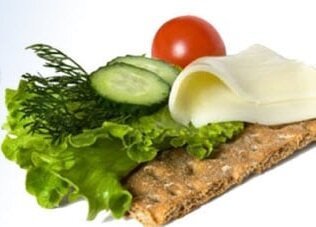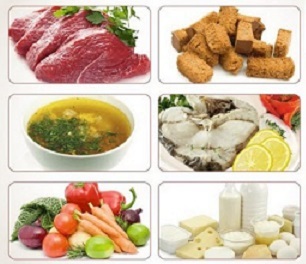The pancreas is an organ in the gastrointestinal tract that participates in endocrine (insulin) and exocrine (enzymes) secretions. Violation of the diet and the quality of nutrition causes irreversible damage to the functions of the pancreas, which is significantly reflected in the quality of its work. Therefore, you need to know what you cannot eat with pancreatitis in order to avoid inflammation of the organ.
What is pancreatitis and how dangerous it is
Chronic pancreatitis with impaired enzymatic function of the gland is a slow progressive chronic disease manifested by abdominal pain, disturbed digestion and absorption of nutrients.
Causes of the disease:
- Eating disorder;
- Eat fatty foods, as well as foods that should not be eaten with pancreatitis;
- Alcohol abuse;
- Eat a lot of sugar and flour products.
And also other diseases of the gastrointestinal tract - gastroduodenal ulcer, gastritis, gastroduodenitis, cholecystitis, cholelithiasis.
Constant violation of the diet, as well as the use of food that is heavy for the stomach, leads to a violation of the secretion of enzymes by the pancreas. In the tissues of the gland, inflammation occurs, followed by hardening of the ducts. Over time, the body cannot make enough enzymes to digest food. All this affects the quality of digestion - undigested fiber appears in the feces, bloating develops in the intestines with fermentation processes, the absorption of necessary substances and vitamins is impaired.
Signs of exacerbation of chronic pancreatitis
Symptoms of chronic pancreatitis:
- Shingles in the abdomen;
- Nausea and vomiting;
- Weight loss;
- Stool disorder in the form of diarrhea or constipation.
In addition, pancreatitis can have such manifestations - general weakness, hiccups, bloating, dry skin, symptoms of vitamin deficiency.
Diet for pancreatic pancreatitis during exacerbation

The main task of the diet in pancreatic pancreatitis is to develop a moderate diet and the choice of such a diet that would reduce the load on the pancreas. Products that increase the acidity of the stomach and stimulate the secretion of enzymes from the pancreas are excluded from the diet, so every patient should know what to eat in chronic pancreatitis.
In the period of exacerbation of chronic pancreatitis, complete hunger is prescribed for 2-3 days, until the symptoms disappear. During this period, you cannot eat any food, even diet. The patient is allowed to drink if he exhibits symptoms of thirst. Treatment is completed with bed rest and complete rest. Cold on the abdomen.
A few days after the disappearance of symptoms of exacerbation of chronic pancreatitis, food is administered according to a specially developed diet. In medical practice, this is table number 5.
The food should be slightly hot. Avoid hot and cold temperatures of food.
Cancellation of products
What should not be eaten in the diet for pancreatic pancreatitis:
- It is categorically contraindicated to eat fatty meats - pork, chicken skin;
- Strong broths (fish and meat) are excluded from the diet, as they have a sokogonny (fermentative) effect and cause pain in the stomach;
- Legumes and cabbage are not allowed - they are not only high in coarse fiber, but will lead to increased gas formation;
- All soft drinks;
- Smoked, fried or grilled foods;
- Products based on coffee, strong tea, chocolate and cocoa should be kept to a minimum;
- Turn off all types of alcohol and fresh bread;
- Ice cream for pancreatitis should be limited;
- Exclude all seasonings - onions, garlic, peppers;
- Hard-boiled eggs;
- Mushrooms in any form;
- Oily fish varieties are excluded - balaur, mackerel, eel, saber, ivasi, caspian sprat, silver carp, notothenia, sturgeon.
What should not be eaten with pancreatitis are candies, pies and sweet tea, as the high sugar content in the intestines causes fermentation and bloating.
In addition, in case of exacerbation of pancreatitis, additional drug therapy is prescribed, which may include the following groups of drugs: proton pump inhibitors (reduce gastric secretion), enzymatic drugs, adsorbents, antispasmodics, pain relievers.
Menu for exacerbation of pancreatitis of the pancreas
Food development
The menu includes the following foods, the use of which provides the body with the necessary nutrients, but at the same time does not have an irritating effect on the pancreas. The food is steamed or boiled and must not contain raw fruits or vegetables.

Soups should be in water or low-fat meat (fish) broth. Best of all mucous or rubbed. Under no circumstances should it be fried in soups. Porridge should be cooked in water or milk diluted in half with water.
Meat and fish should be included in the menu. But not the fatty varieties. The most dietary fish is cod, which contains 1, 4% fat. These fish are quickly digested by the gastrointestinal tract and are easily digested. It does not cause a strong stimulation of the enzymatic function of the pancreas, so it is considered optimal for pancreatitis.
For meat, preference is given to rabbit, turkey, fillet of beef or chicken breast. Steamed, baked or boiled meat products. You can cook meatballs or vegetable cutlets.
The menu includes the following dishes:
- steamed, boiled or stewed vegetables;
- Bread "from yesterday";
- baked fruit (apples);
- foods low in lactic acid fat;
- drinks - compote, jelly, weak tea;
- lean meats - chicken breast, turkey, beef and veal tenderloin, rabbit;
- low-fat marine fish - pollock, blue whiting, hake, plaice, roach, cod;
- Lean river fish - bream, perch, pike, pike perch, crucian carp, tench.
The last meal should take place no later than 2 to 3 hours before bedtime. For a snack before bedtime, cookies and compotes or jelly are preferred.
Menu design
Sample menu for a day with chronic pancreatitis. Products that can not be consumed with disease of the pancreas are turned off, and a diet that is as gentle as possible on the body is selected.
- Breakfast:Steamed omelet, boiled boiled in milk (buckwheat, rice or other), half and half with water and weak tea. Option: semolina porridge without oil, dried fruit compote with biscuit biscuits;
- Second breakfast (lunch):low-fat cottage cheese about 100 gr, jelly or compote. Option: baked apple or curd casserole;
- Lunch:vegetarian soup, boiled chicken breast and dried fruit compote. Option: soup without frying, steamed meatloaf, rosehip broth;
- Snack:baked apples or crackers with rosehip decoction. Option: a glass of low-fat kefir;
- Dinner:mashed vegetables (potatoes, zucchini, carrots), steamed cutlets, herbal tea. Option: porridge with milk, boiled chicken breast, jelly;
- Evening snack:a glass of low-fat kefir or fermented baked milk or fruit jelly. Option: rosehip decoction.
When asked if ice cream can be used for pancreatitis - the answer can be given - they limit the use of fatty and very sweet ice cream. You can only include ice cream in the diet, no more than ½ packet and without any additions (chocolate, nuts, condensed milk).
Patient note

Each patient should know the rules of diet and what not to eat with pancreatitis.
Take the recommendations into account:
- Meals should be divided, that is, in small portions up to 5-6 times a day;
- They adhere to the regimen for at least six months, although in the end the patient must adhere to such a regimen throughout life;
- Foods should be high in calories as needed;
- Do not eat foods from the above list that you should not eat if you have pancreatic disease;
- Overfeeding is not allowed;
- Is this possible with pancreatitis ice cream - limited use of low fat ice cream.
In addition, timely treatment of all diseases of the gastrointestinal tract is necessary to prevent complications and reduce the number of exacerbations of the disease.




























